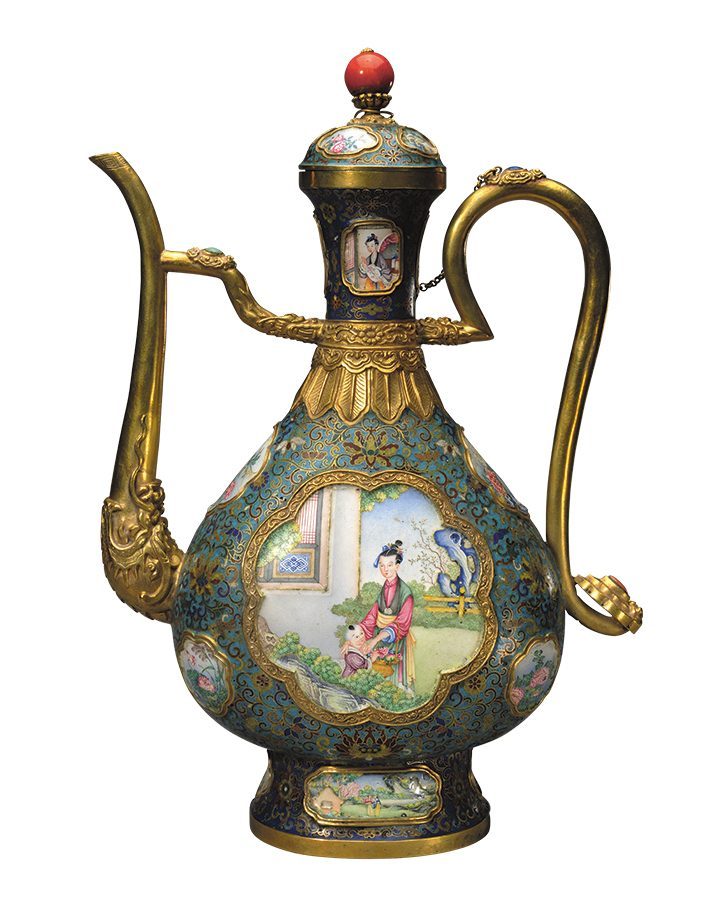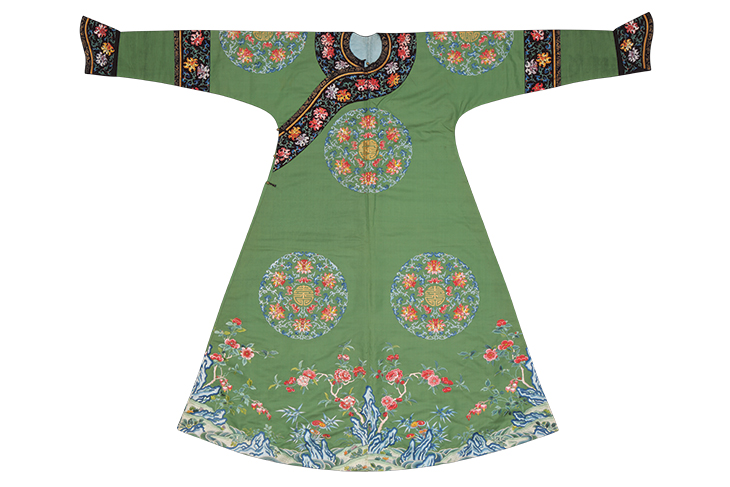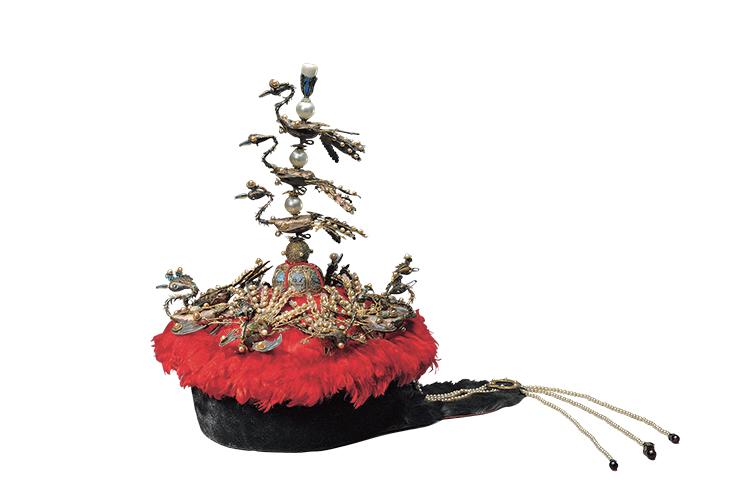The curators Daisy Yiyou Wang and Jan Stuart were told by fellow scholars of Chinese art that a show focusing on empresses and their arts would necessarily be second-rate. ‘It was always assumed that all art ordered by the emperor was for him, but now I’m not so sure,’ Wang tells me. This visually dramatic show states their case. It is packed with new research and 200 rare loans from Beijing’s Palace Museum (housed in the Forbidden City), most of them visiting America for the first time. It reveals that women took a far more active and influential role in court life and culture than has been thought.
At the entrance, eight big banners hang from the ceiling, each printed with a portrait of a pale-faced, determined woman looking out from an expanse of sumptuous silk robes. In the galleries beyond, the visitor can find the actual portraits, which are large and imposing, painted on silk scrolls. These women are eight out of the more than two dozen empresses – ‘mothers of the state’ – who lived during the last Chinese dynasty, the Qing, which ruled from 1644 until 1912 and the abdication of the last emperor. Wang and Stuart have chosen to concentrate on five women ‘for whom the historical and visual records are more complete’. They looked at hundreds of court edicts that are now digitised and accessible in China’s National Archives, and at the very detailed 18th-century archives of the royal workshops, and they carefully studied objects that have never left their storerooms in the Palace Museum. By looking at the increase in the numbers of commissions by emperors at times of births, birthdays and deaths, and at the objects themselves, and by ploughing through reams of documents, Wang and Stuart came to the conclusion that 80 per cent of the objects in the show were made for women, and the rest were of kinds used by women.
Ewer with lady and boy in Garden (Qianlong period; probably 1760s/70s), Imperial Workshop, probably Beijing. Palace Museum, Beijing

A sumptuous and technically spectacular ewer made in the imperial workshops in the 1760s or ’70s has a solid gold body coated with fine cloisonné work (a technique introduced from Europe the previous century) surrounding gilded cartouches of painted enamel scenes. The paintings show a woman and boy in a garden, which members of the Qing court would know symbolised fertility and motherliness. The ewer was once in the inventory of the Palace of Eternal Longevity, where high-status imperial women lived. Empress Dowager Chongqing lived here, and ewers of this type and decoration represented in the large painting recording her 80th birthday celebrations in the Forbidden City in 1771. The ewers are the tallest objects on a display table laden with exquisite pieces, perhaps birthday presents. It has previously been argued that gold-core enamelware was reserved for Qing emperors alone.
Empress Xiaoxian (1777; with repainting in 19th [?] century), Ignatius Sichelbarth, Yi Lantai and possibly Wang Ruxue. Peabody Essex Museum, Salem, Massachusetts

Some of Wang and Stuart’s research has revealed new information about items in US collections, such as the silk scroll-painting of a regal-looking woman acquired in the 1950s by the Peabody Essex Museum. The sitter is the Empress Xiaoxian, who revived elaborate silk-making rituals. It is, in effect, part of a triptych showing Xiaoxian, her husband the Qianlong emperor and another of his wives, Empress Xiaoyi; the other two paintings have remained in Beijing. Xiaoxian died in 1748, aged 36, while travelling with her husband. A poem composed by the grief-stricken emperor 13 days later is displayed nearby, ending, ‘My tortured soul is dark, and I toss my brush away.’ So, too, is a eulogy to her commissioned by the next emperor, her stepson, written on slabs of deep green jade in 1799, after the Qianlong emperor’s death: protocol insisted that such things could only be completed after her husband had been given his posthumous name, which could be added to hers.
Exhibited beside the great empress portraits are miraculous survivals of their colour-saturated, densely embroidered silk court vests and some of their ridiculously elaborate festive headdresses. One such, decorated with phoenixes and peonies, was given to the Rhode Island School of Design Museum in the 1930s and can now be confidently dated to the second half of the 19th century, thanks to comparisons with ones in the Palace Museum.
Festive robe with bats, lotuses and the character for longevity, Jiaqing period (1796–1820), Suzhou (embroidery) and Imperial Workshop Beijing (tailoring). Palace Museum, Beijing

Throughout the galleries the visitor is helped to penetrate the inner life of the mysterious Forbidden City. A film taken from the bumpy viewpoint of a bride being carried through the Forbidden City’s courtyards in her palanquin brings alive the close research done on a wedding album recording the marriage of the Guangxu Emperor Qing Kuan. Wang says that many of the paintings it contains were clearly made from a female perspective, describing female events. One depicts Empress Xiaoding’s entourage leaving her parents’ home for the palace in 1889.
Court hat with phoenixes (18th or 19th century), probably Imperial Workshop, Beijing Palace Museum, Beijing

The Peabody Essex Museum at Salem, a 30-minute train ride outside Boston, may not seem an obvious location for such a major show. But in the 18th century Salem’s port was larger than Boston’s. Its merchants were trailblazers for American east coast trade with Asia, and it was they who gave objects they brought back to found their city’s museum in 1799. Today, it has one of the finest Asian art collections in the United States – including an entire 200-year-old Chinese house, the only one in the US – displayed in Moshe Safdie’s uplifting ship-inspired building of 2003; an expansion by Ennead Architects is due to open next year. The museum also owns 24 historic buildings in the area, some open to visitors.
The exhibition has been organised to mark 40 years since the establishment of US-China diplomatic relations, on 1 January 1979. It is the museum’s third collaboration with the Palace Museum but their first time working with the Smithsonian’s Freer|Sackler Galleries in Washington, D.C., where the exhibition will go next year (30 March–23 June 2019). Not all scholars living in China are pleased: they must either travel to the US or hope that these rarely seen masterpieces will go on public display when they return to the Palace Museum. ‘China has strict conservation rules,’ Wang says. ‘They might not go on exhibition there. So, take advantage now!’
‘Empresses of China’s Forbidden City’ is at the Peabody Essex Museum, Salem, until 10 February.
From the November 2018 issue of Apollo. Preview and subscribe here.



